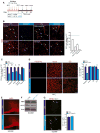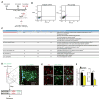Genetic and Stress-Induced Loss of NG2 Glia Triggers Emergence of Depressive-like Behaviors through Reduced Secretion of FGF2
- PMID: 26606998
- PMCID: PMC5354631
- DOI: 10.1016/j.neuron.2015.10.046
Genetic and Stress-Induced Loss of NG2 Glia Triggers Emergence of Depressive-like Behaviors through Reduced Secretion of FGF2
Erratum in
-
Genetic and Stress-Induced Loss of NG2 Glia Triggers Emergence of Depressive-like Behaviors through Reduced Secretion of FGF2.Neuron. 2019 Nov 20;104(4):825-826. doi: 10.1016/j.neuron.2019.11.005. Neuron. 2019. PMID: 31751546 No abstract available.
Abstract
NG2-expressing glia (NG2 glia) are a uniformly distributed and mitotically active pool of cells in the central nervous system (CNS). In addition to serving as progenitors of myelinating oligodendrocytes, NG2 glia might also fulfill physiological roles in CNS homeostasis, although the mechanistic nature of such roles remains unclear. Here, we report that ablation of NG2 glia in the prefrontal cortex (PFC) of the adult brain causes deficits in excitatory glutamatergic neurotransmission and astrocytic extracellular glutamate uptake and induces depressive-like behaviors in mice. We show in parallel that chronic social stress causes NG2 glia density to decrease in areas critical to Major Depressive Disorder (MDD) pathophysiology at the time of symptom emergence in stress-susceptible mice. Finally, we demonstrate that loss of NG2 glial secretion of fibroblast growth factor 2 (FGF2) suffices to induce the same behavioral deficits. Our findings outline a pathway and role for NG2 glia in CNS homeostasis and mood disorders.
Copyright © 2015 Elsevier Inc. All rights reserved.
Figures








References
-
- Almeida RF, Thomazi AP, Godinho GF, Saute JA, Wofchuk ST, Souza DO, Ganzella M. Effects of depressive-like behavior of rats on brain glutamate uptake. Neurochem Res. 2010;35:1164–1171. - PubMed
-
- Alonso G. Prolonged corticosterone treatment of adult rats inhibits the proliferation of oligodendrocyte progenitors present throughout white and gray matter regions of the brain. Glia. 2000;31:219–231. - PubMed
-
- Asano H, Aonuma M, Sanosaka T, Kohyama J, Namihira M, Nakashima K. Astrocyte differentiation of neural precursor cells is enhanced by retinoic acid through a change in epigenetic modification. Stem Cells. 2009;27:2744–2752. - PubMed
Publication types
MeSH terms
Substances
Grants and funding
LinkOut - more resources
Full Text Sources
Other Literature Sources
Medical
Molecular Biology Databases
Research Materials
Miscellaneous

